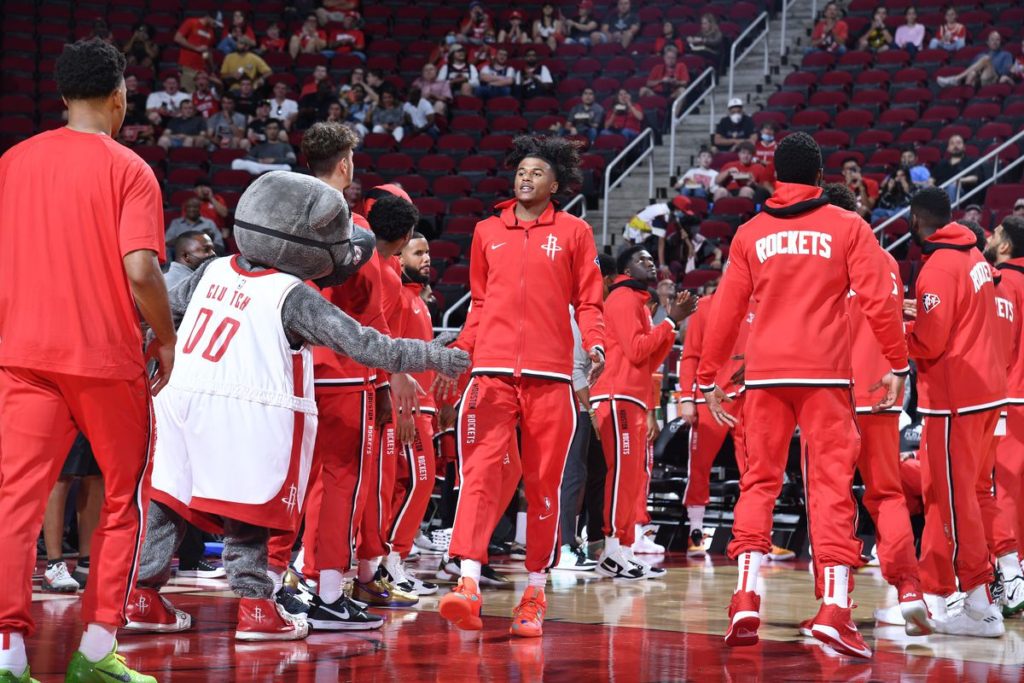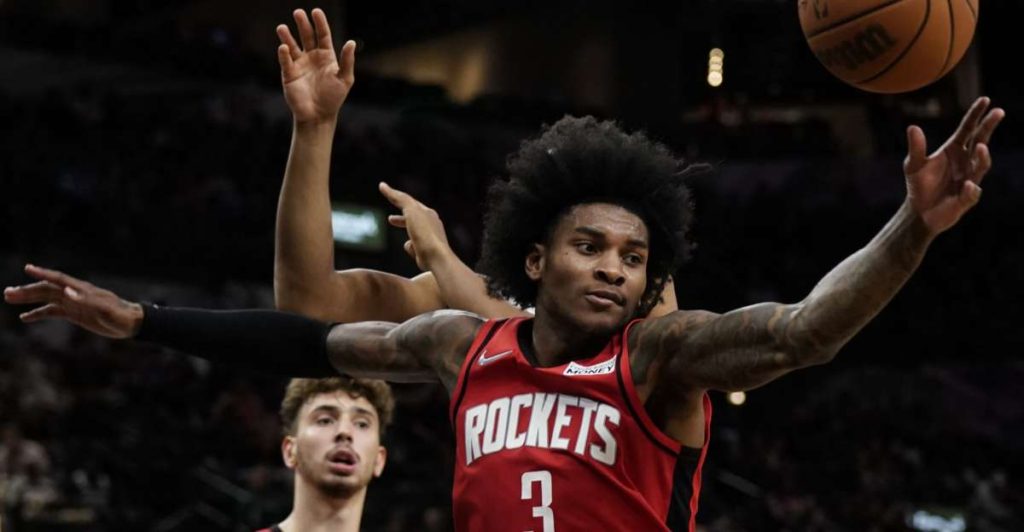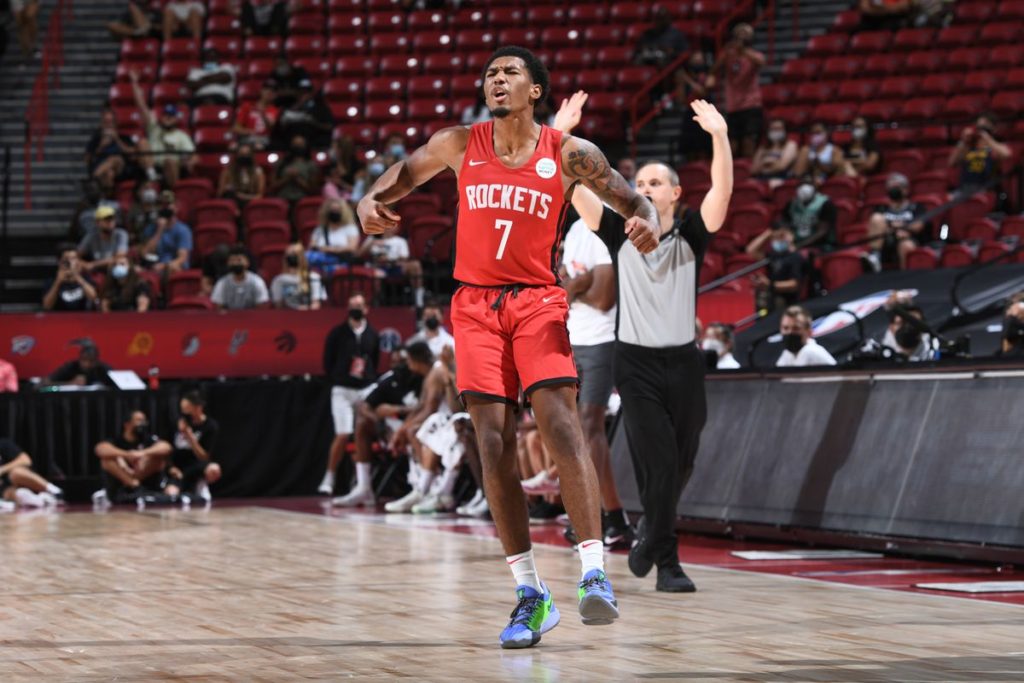Here’s to the first Houston Rockets’ Round-Up with actual basketball to talk about. No more “who to root for” or “what could the alternate jersey look like;” not there have been real-life NBA games to watch and analyze.
Ok, admittedly… in many ways, a handful of preseason games isn’t exactly the same. Stephen Silas used 15 players in Game One and utilized his entire roster in each game. That isn’t real NBA basketball, but it was basketball played by the real Houston Rockets.
The Houston Rockets are as interesting a team as the NBA has without a strong chance at an NBA championship (odds for Houston are typically +50000). Success for the Houston Rockets this year will be qualitative, not quantitative. After drafting four teenagers, Houston boasts the youngest NBA roster at 23.7 years old. That includes 31-year-old John Wall, who will reportedly serve the Rockets as a coach and mentor that doesn’t play in games until he is eventually traded.
Houston’s success this year is entirely their growth. In May, Houston needs to know Kevin Porter Jr. is the long-term Point Guard and creator. They need to know Jalen Green is a star they can build a franchise around. The Rockets need to know Stephen Silas is the right personality to lead these young guys on their path. And they need to know Christian Wood fits in as the versatile big.
Multiple Starting Lineups

Head Coach Stephen Silas surprised everyone when he went with a three-guard lineup to start the first preseason game against the Washington Wizards. The Houston Rockets starting lineup Kevin Porter Jr., Jalen Green, Eric Gordon, Christian Wood, and Daniel Theis. Against the Miami Heat, Houston let Eric Gordon sit in street clothes and opted to play Danuel House Jr. Against the Toronto Raptors, both sat and Houston played Jae’Sean Tate. And the San Antonio Spurs saw a fourth starting lineup. Houston opted to rest Daniel Theis and start the young Alperen Sengun.
To Coach Silas’s credit, the preseason is as good a time as any to experiment. The Rockets have a number of options to rotate through the three frontcourt spots and each offers different strengths and weaknesses. Eric Gordon adds a veteran presence, can stretch the floor and is a stout defender. He’s also a true guard and is playing undersized at the “three.” Danuel House adds length but is a more traditional three-and-D player that doesn’t create offense the same way Gordon can.
The six-foot-four Tate is a jack of all trades, but the only one he’s close to mastering is his effort. Daniel Theis offers leadership and toughness but is a limited offensive player. And Alperen Sengun, the 19-year-old rookie and Turkish League MVP, will grow into an NBA starter… but can the Rockets take the growing pains of playing him, Green, and Porter Jr. (three players under 21-years-old) for extended periods of time together?
This isn’t something Houston’s figured out at this point, and it isn’t something they have to either. The Houston Rockets will play one of the youngest rosters in NBA history this season. That means they’ll grow and develop together as the season goes on. Not counting two-way G League contracts, 10 of their 15 men on the roster were in the G League, Overseas, High School, or College to start the 2018-19 season. The 2018-19 Rockets season feels like decades ago, and Houston did have an entirely different roster with a pair of future Hall of Famers in the backcourt… But with the right growth and development, who’s to say the Rockets don’t still?
Houston rotated starting lineups last year a lot… they had more starting lineups than any other NBA team. But that was after a number of roster moves and some key injuries. This season, while they shouldn’t lead the league in lineup changes, you can expect them to shift the lineup as kids grow up and they begin to move on from the “olde guarde” of Rockets. Newly signed Armoni Brooks should be playing more minutes in March and April than he will in October and November. Alperen Sengun will be a starter, and pairs well next to Christian Wood.
If the shifting lineups of the preseason offered anything, it’s a glimpse at the intentionality with which Houston will move their roster around. Gordon and House will likely see reduced roles, if not new franchises, before the end of the year. They’re the lone holdovers from the 2018-19 playoff run. While they offer a wealth of experience and have had memorable moments in Houston, a move is mutually beneficial. Both Gordon and House can contribute on championship-caliber teams in the present tense, and giving their minutes to younger Rockets will help in their development.
The Green Light

In all four preseason contests, all eyes were on the short shorts, long hair, and blazing speed of number two overall pick Jalen Green. Green had moments that he shined bright; he blew by Kyle Kuzma in the opening game against Washington, he hit and-one floaters and put-backs against the veteran San Antonio Spurs. He put up 20 points, in limited minutes, on a strong Miami Heat defense that included a number of pairs of deep threes. When Toronto layered defense to stop him? He led the team in assists in his 25 minutes as the two-guard.
But Green also made a number of mistakes in his first four games as a Houston Rocket. He often looked stagnant in the halfcourt with the Washington Wizards, was out physical-ed against a stout Miami defense. Green was going through growing pains in front of our very eyes.
But one thing was very clear when watching Green across all four preseason games: there are things Green can do that can’t be taught. He is Hall of Fame level explosive and quick, when he puts his mind on going downhill he has an instinct for beating defense, and he’s got the swagger to lead a team and franchise. That much is already obvious, even as we’re still months away from the teenager’s 20th birthday.
Where Green was most comfortable attacking was above the break and beyond the arc. The angles from the two extended wings give him multiple directions to shift the defense and enough room to bounce the other way. Coach Stephen Silas mentioned keeping some cards up his sleeve, but in offenses from last year, this puts him in on both sides of the ball-screen actions opposite backside hammer screens for the other guard. Silas utilizes space by having all five players beyond the three-point line, and that opens up the space for Green to be a real attacking threat. In a sense, Silas’s offense was built for a guy like Green to attack from the perimeter because no single defender will be able to stay in front of him.
Against Minnesota, I’m looking for what wild cards Silas shows. Perhaps he runs Green off of a pistol action, which is an offense Rockets fans should understand from watching James Harden burst from the corner to the top of the key off of a screen and dribble-hand-off combination. Houston has shown the set in the preseason but used Porter Jr. as the man coming off of the screen. Flipping their roles may play better to their strengths, as Green could shoot off of the handoff at a much more efficient clip.
Scootin’

The player who’s shown the most growth in the preseason since last season, and leaves Rockets’ fans most optimistic, has to be Kevin “Scoot” Porter Jr. In his shift to the point guard position, Scoot has really become a dual-threat creator in the Stephen Silas offense. While his stat line in the opening game with the Washington Wizards grabbed everyone’s attention, his crafty play while driving has already become routine. Off of the one-five pick and roll action, he’s mastered the deceptive “floater-lob.” When he’s attacking downhill, and the roller is as well, Porter Jr. floats the ball at the rim, and defenders are left wondering what flies above them.
Porter Jr. is undoubtedly the biggest beneficiary of John Wall using his roster spot functionally as a coach. At his peak, John Wall was a point guard that logged an explosive 23.7 points and 10.7 assists a night. His entire career was straddling being a scoring guard and a creating one. As Porter Jr. shifts from a small forward to a shooting guard and now into a point guard, he’s going to continue to learn how to best use his scoring abilities off of the bounce to open up creating offense for others.
Last season, Porter Jr. averaged 16.6 points and 6.3 assists a night, but he had to alternate his role from night tonight. Some nights, he shared the backcourt with Wall and had to play the off-guard in half-court sets. Others, he’d be playing point guard with Eric Gordon and Armoni Brooks running the off-guard. And in a smaller number of games, he’d be switching back and forth on the same night.
Having a set role, from opening night on, should help slow the game down for Scoot. After joining the Rockets mid-season, Porter Jr. then went to the G League bubble. He then was dropped into a Rockets roster that was shuffling injured players around constantly. Having a consistent backcourt with Jalen Green will benefit Scoot immensely. While there may be growing pains, being able to grow together in the backcourt will be huge. The pair ought to be better in April than they are in February, better in February than in December, and better in December than now.
Porter Jr. appears to be a perfect “yin” for Green’s “yang.” Green is explosive and all fast-twitch muscle fibers; Porter Jr. is methodical and crafty. Green launches threes from feet beyond the arc; Porter Jr. pulls the ball back like a yo-yo to hit a midrange stepback. The offensive diversity that Porter Jr. brings really multiplies the Silas offense. Defense needs to prepare for him to do very different things than Green from many of the same spots. In the preseason we saw both Scoot and Green involved in dribble handoffs with big men, both were involved in isolations just above the break, and both were coming off of screen actions to catch the ball across the court from the other. Where Porter Jr. may not have Green’s speed, his experience (albeit just 76 career games) will help him diagnose defenses much more fluidly earlier in the year.
No More Armoni Exchange

One of the Houston Rockets’ biggest moves this month has been officially converting Armoni Brooks from a G League contract to a two-way contract and then to a four-year, $7 million contract. Brooks is a sharpshooter that helps spread the floor for the likes of Green and Porter Jr. The starting backcourt players are growing into their respective roles, but Armoni Brooks has always had just this one. As a shooter, he will pull defenders out of help with him as he sets pin down screens, spots up in the corner, or flips for an inverted horn set. Armoni Brooks is simply someone the defense has to account for because, at a clip of over 38-percent, he’s too good a shooter to leave open.
While Brooks is two years older, he is very much in the same stage of his career as Houston’s other young guards. He is going to grow up before our eyes with Green and Porter. There will be growing pains where Green punctures a defense and assumes Brooks is in one spot, but he is sprinting to spot up in another. There will be times when Porter Jr. throws a no-look pass after a stepback and expects it to turn into a give and go, but the ball sits in Brooks’s hands.
That’s all understandable given their ages and playing experience. But what’s also going to happen is Armoni Brooks will continue to hit big shots. The G League, Summer League, and preseason aren’t the same bright lights that an NBA regular-season game is, much less a postseason game. But Brooks has hit big three-pointers on every level he’s played at.
A three-guard lineup of Green, Porter Jr., and Brooks will hurt defensively. Yes, Porter Jr. is six-foot-six (even if it was an often discussed topic this off-season). And yes, Jalen Green is six-foot-six as well. But neither of them nor the six-foot-three Armoni Brooks, are the stout defenders that Rockets backcourts have had for much of the last decade. The trio of young guards in Houston will spread the floor and score, but they’re going to go through growing pains defensively. This likely means they continue to rotate in two at a time, as Silas did for much of the preseason until they begin to understand the complex defensive coverages of NBA competition.
Struggles in physicality
The Houston Rockets looked, in a phrase, outmuscled in the preseason. The physicality of the Miami Heat and Toronto Raptors really altered much of what the free-flowing Rockets offense wanted to accomplish. It should shock no one, but hearing Jalen Green articulate it was humbling. The physical nature of the NBA shook the Houston Rockets in the present tense, but in the long term growing pains like that, for the duration of the season, will be a good thing.
Further, Houston played these games without the few veterans they do have that could have “fought back.” Eric Gordon, known for his tough defense, didn’t play in either game. Danuel House didn’t play against Toronto after he played poorly on a bad ankle against Miami. Daniel Theis started both games but played 22 and 16 minutes against Miami and Toronto respectively before sitting out the San Antonio game. As a whole, the preseason was thrown to the young Rockets.
Offensively, this got fans excited about the future of the aforementioned Green and Porter Jr. Alperen Sengun’s body of work has Rockets Twitter questioning Silas’s starting lineup. It’s got basketball Instagram hoping that KJ Martin’s seven-foot-and-over block party from last season continues this year. But what it also made very obvious is, as Green said, the NBA is a league of grown-ups. Houston? They’ve got four teenagers, and eight players 23-years-old or younger. For reference, Gonzaga is the number one NCAA men’s team in the preseason AP poll. They have four players who will be 22-years-old or older this season. The University of Houston is ranked 15th, and they’ll feature five players turning 22 or older this season. The Houston Rockets are young.
That doesn’t mean the Houston Rockets won’t learn to play with an NBA physicality, but it does mean that the adjustment will take time. It’s important for Rockets’ fans and Rockets’ Round-Up readers to remember: this entire year is about growth. If they get hit in the mouth by physical championship contenders like Miami, the goal is to learn from it and be better because of it. Miami has PJ Tucker, Kyle Lowry, Jimmy Butler, and Bam Adebayo… four physical players who put their team at a different point of the championship building process. They’re contending in the present tense. Toronto has Pascal Siakam and OG Anunoby, they’re coming off of a 2019 title and are retooling, not rebuilding.
Rockets games start Wednesday night with the Minnesota Timberwolves… Check back for more each week (if not more often!) on Belly Up Sports!







